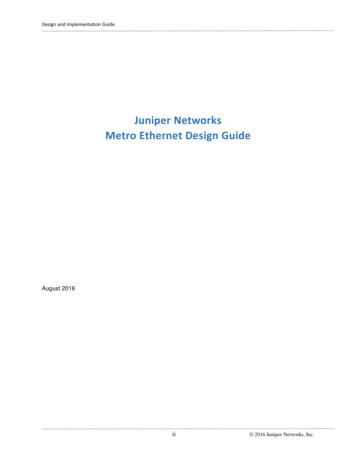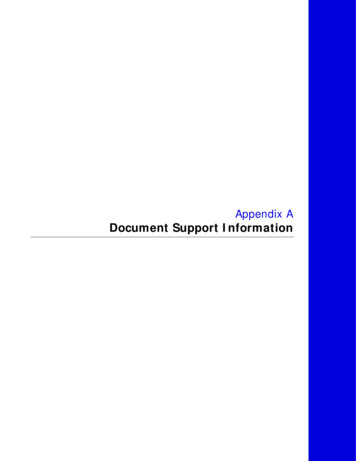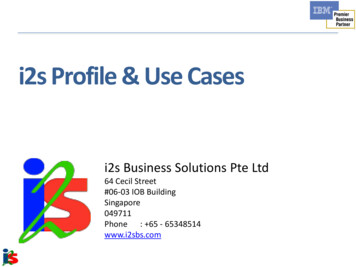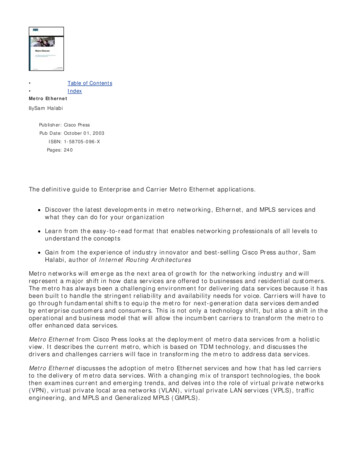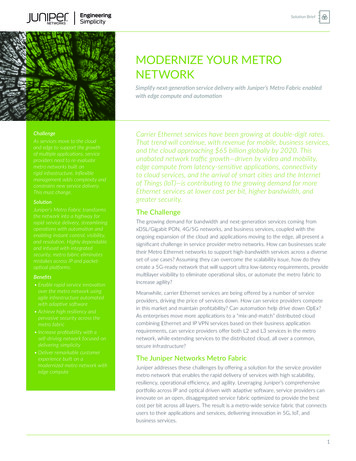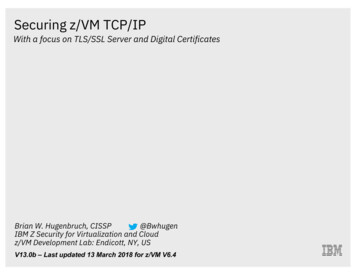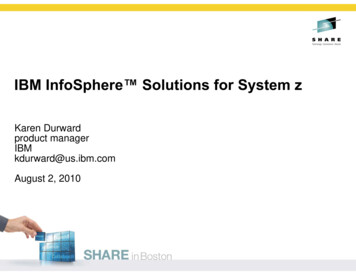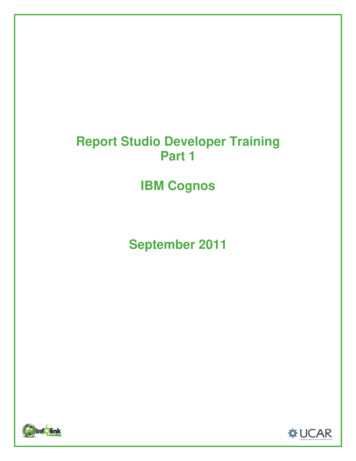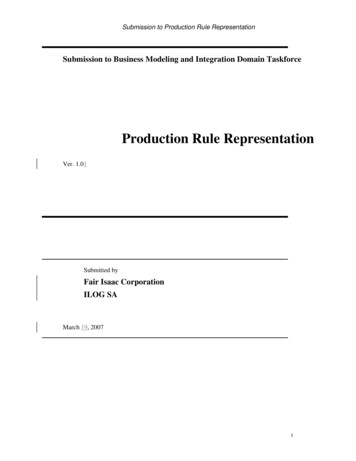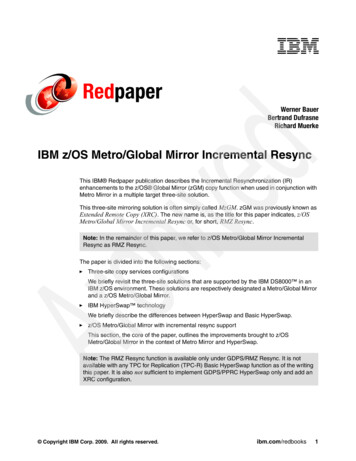
Transcription
RedpaperWerner BauerBertrand DufrasneRichard MuerkeIBM z/OS Metro/Global Mirror Incremental ResyncThis IBM Redpaper publication describes the Incremental Resynchronization (IR)enhancements to the z/OS Global Mirror (zGM) copy function when used in conjunction withMetro Mirror in a multiple target three-site solution.This three-site mirroring solution is often simply called MzGM. zGM was previously known asExtended Remote Copy (XRC). The new name is, as the title for this paper indicates, z/OSMetro/Global Mirror Incremental Resync or, for short, RMZ Resync.Note: In the remainder of this paper, we refer to z/OS Metro/Global Mirror IncrementalResync as RMZ Resync.The paper is divided into the following sections: Three-site copy services configurationsWe briefly revisit the three-site solutions that are supported by the IBM DS8000 in anIBM z/OS environment. These solutions are respectively designated a Metro/Global Mirrorand a z/OS Metro/Global Mirror. IBM HyperSwap technologyWe briefly describe the differences between HyperSwap and Basic HyperSwap. z/OS Metro/Global Mirror with incremental resync supportThis section, the core of the paper, outlines the improvements brought to z/OSMetro/Global Mirror in the context of Metro Mirror and HyperSwap.Note: The RMZ Resync function is available only under GDPS/RMZ Resync. It is notavailable with any TPC for Replication (TPC-R) Basic HyperSwap function as of the writingthis paper. It is also not sufficient to implement GDPS/PPRC HyperSwap only and add anXRC configuration. Copyright IBM Corp. 2009. All rights reserved.ibm.com/redbooks1
Three-site Copy Services configurationMany companies and businesses require their applications to be continuously available andcannot tolerate any service interruption. High availability requirements have become asimportant as the need to quickly recover after a disaster affecting a data processing centerand its services.Over the past years, IT service providers, either internal or external to a company, exploitedthe capabilities of new developments in disk storage subsystems. Solutions have evolvedfrom a two-site approach to include a third site, thus transforming the relationship betweenthe primary and secondary site into a high availability configuration.IBM addresses these needs and provides the option to exploit the unique capabilities of theDS8000 with a firmware-based three-site solution, Metro/Global Mirror. Metro/Global Mirror isa cascaded solution. All Copy Services functions are handled within the DS8000 firmware.Metro/Global Mirror also provides incremental resync support when the site located inbetween fails, as discussed in “Metro/Global Mirror configuration” on page 2.In contrast to Metro/Global Mirror, Metro Mirror/z/OS Global Mirror or MzGM is a combinationof DS8000 firmware and z/OS server software. Conceptually MzGM is a multiple targetconfiguration with two copy relationships off the same primary or source device. More detailsfollow in “Metro/zOS Global Mirror” on page 3.Being entirely driven by the DS8000 firmware, Metro/Global Mirror offers an advantage overMzGM in that it is independent from application hosts and volume specifics such as CKDvolumes or FB volumes. Metro/Global Mirror handles all volumes without any knowledge oftheir host connectivity. MzGM through its zGM component is dependent on z/OS.Consequently, it can handle only CKD volumes and requires time-stamped write I/Os.The benefits of zGM when compared to GM include the requirement for less disk space (zGMrequires only a single copy of the database at the remote site, compared to two copies withGM) and greater scalability (zGM can handle much larger configurations than GM).The “three-site configuration” terminology can also mean simply three copies of the datavolumes. The differentiation between “site” and “copy” basically refers to three copies, andeach copy might reside at a distinct site. Metro/Global Mirror or MzGM often have both MetroMirror volumes located at the same site, and only the third copy is located at a second site.Metro/Global Mirror configurationMetro/Global Mirror is a cascaded approach, and the data is replicated in a row from onevolume to the next. Figure 1 on page 3 shows the Metro/Global Mirror cascaded approach.The replication from Volume A to Volume B is synchronous, while the replication from VolumeB to Volume C is asynchronous.Volume B is the cascaded volume, and it has the following two roles:1. Volume B is the secondary or target volume for volume A.2. At the same time, volume B is also the primary or source volume for volume C.Combining Metro Mirror and continue with Global Mirror places the middle volume in aconfiguration that is known as cascaded.2IBM z/OS Metro/Global Mirror Incremental Resync
Parallel n487Application65GMAMMBGCcascadedMetropolitan site(s)MMGCGMMetro MirrorGlobal CopyGlobal MirrorCFlashCopyDRemote siteFigure 1 Three-site cascaded configurationThe Metro/Global Mirror function is provided and driven solely by the storage subsystemfirmware. During normal operations, no software is involved in driving this configuration. Thissituation applies especially to the Global Mirror relationship where the firmware autonomicallymanages the formation of consistency groups and thus guarantees consistent data volumesat all times at the remote site. However, to handle exceptions and failure situations, a(software) framework must be wrapped around a Metro/Global Mirror configuration. Thefollowing alternatives manage such a cascaded Metro/Global Mirror configuration, includingplanned and unplanned failovers: GDPS/PPRC and GDPS/GM TPC-R DSCLI and REXX scriptsThis software framework is required to handle planned or unplanned events in either site.IBM GDPS also manages an incremental resync when site B fails and A needs to connectincrementally to C/D and to continue with Global Mirror (GM) from A to C/D.Metro/Global Mirror management through GDPS also includes implementing HyperSwapwhen A fails or a planned swap is scheduled to swap all I/Os from A to B. The swap istransparent to the application I/Os, and GM continues to replicate the data from B to C/D.We do not discuss this Metro/Global Mirror configuration any further in this paper. For moreinformation, refer to GDPS Family - An Introduction to Concepts and Capabilities,SG24-6374.Metro/zOS Global MirrorMetro/Global Mirror is applicable to all volume types in the DS8000, including Fixed Block(FB) for all open systems attached volumes as well as for Count-Key-Data (CKD) volumesattached to System z operating systems such as z/OS or z/VM . The HyperSwap functionIBM z/OS Metro/Global Mirror Incremental Resync3
is applicable to CKD volumes managed by z/OS. In addition to z/OS volumes, GDPScontrolled HyperSwap activities serve Linux volumes under native Linux or Linux as z/VMguest.MzGM is a three-site multiple target configuration in a System z environment. MzGMcombines firmware in the DS8000 with software in z/OS.1 Software support is provided inz/OS through the System Data Mover (SDM) component, which is supported by current z/OSrelease levels.Figure 2 shows a MzGM configuration.Parallel rimaryMetropolitan site(s)DCSecondarySDM System Data MoverJournalRemote siteFigure 2 Three-site multiple target configuration, MzGMIn Figure 2 the A volume or primary volume is located in the middle position of the A, B, C,and D volume set.A is the active application volume with the following two copy services relationships:1. Metro Mirror relationship between A and BVolumes A and B are in a synchronous copy services relationship and are the base forpotentially swapping both devices through HyperSwap. This topic is discussed later in“z/OS Metro/Global Mirror” on page 17.2. zGM relationship between A and CThis relationship is managed by the SDM. An associated zGM session contains all A andC volumes, with all A volumes that are also in a Metro Mirror relationship with B.14IBM DS8000 firmware level (LIC) V3.1 or laterIBM z/OS Metro/Global Mirror Incremental Resync
The following two points describe how GDPS/MzGM must be used to establish and manageboth sessions: GDPS/PPRC for the Metro Mirror configuration between A and B GDPS/XRC for zGM and all A and C volumes.The journal or D volumes are used by SDM only.The number of D volumes depends on the number of zGM volume pairs and the amount ofdata that is replicated from A to C because all replicated data is written twice in the remotelocation:1. Writes to SDM journal data sets on these D volumes. We recommend you dedicate the Dvolumes to SDM journals only. SDM Journal volumes usually number 4 to 16, but with theHyperPAV support by SDM, these journals might be consolidated onto fewer D volumes.You must ensure that sufficient alias devices are available. Allocate journals as stripeddata sets across two devices. For details on zGM setup and configuration, refer to z/OSV1R10.0 DFSMS Advanced Copy Services, SC35-0428.2. Apply all writes on the secondary in the same sequence as they occur on the primaryvolumes.With the advent of HyperSwap with the Metro Mirror configuration between Volume A and Bas shown in Figure 2 on page 4, zGM loses its active primary volume (volume A) because ofthe transparent swap (HyperSwap). Thus, you must create a new zGM session and perform afull initial copy between volume A and volume C.This process has been enhanced with MzGM/IR support and is described in the section“z/OS Metro/Global Mirror” on page 17.HyperSwap technologyBecause z/OS Metro/Global Mirror Incremental Resync relies on z/OS HyperSwap services,this section includes an overview of the z/OS HyperSwap function. It covers two currentlyavailable alternatives for interfacing with the HyperSwap service that z/OS provides.The following HyperSwap interfaces alternatives are available: GDPS/PPRC HyperSwap Manager or the full GDPS/PPRC HyperSwap functionHyperSwap Manager provides only the disk management function with single sites ormultiple site configurations. The full function GDPS/PPRC HyperSwap solution alsoincludes the server, workload, and coordinated network switching management. TPC for Replication (TPC-R) provides Basic HyperSwap. Basic HyperSwap and someimplementation details are covered in a separate paper, DS8000 and z/OS BasicHyperswap, REDP-4441.Another goal of this section is to clarify the current purpose, capabilities, and limitations ofthese two management frameworks, which utilize the z/OS Basic HyperSwap services withintheir individual functions. This section also can help you understand the difference betweenwhat commonly is understood as HyperSwap, which relates to GDPS, and Basic HyperSwap,which is provided by TPC-R.For details on TPC-R under z/OS and Basic HyperSwap refer to the following sources: IBM TotalStorage Productivity Center for Replication for Series z, SG24-7563 DS8000 and z/OS Basic Hyperswap, REDP-4441IBM z/OS Metro/Global Mirror Incremental Resync5
For more information about the HyperSwap features that GDPS provides, refer to GDPSFamily - An Introduction to Concepts and Capabilities, SG24-6374.Peer-to-peer dynamic address switching (P/DAS)In the mid-1990s, a first attempt was made to swap disk volumes, more or less transparentlyto application I/Os, from a PPRC primary volume to a PPRC secondary volume. This processwas called peer-to-peer dynamic address switching (P/DAS). The process was singlethreaded for each single device swap and was serially executed for each single PPRC pair oneach single z/OS image within a Parallel Sysplex . It also included a process that halted allI/O first to the impacted primary device and included additional activities before issuing theactual swap command. After the swap successfully ended in all systems belonging to theconcerned Sysplex, the stopped I/O was released again. From that point on, all I/O wasredirected to the former secondary device.This first attempt was intended to provide continuous application availability for plannedswaps. P/DAS was not intended for unplanned events when the application volume failed.Therefore, P/DAS contributes to continuous availability and is not related to disaster recovery.P/DAS is not suited for large configurations, and the amount of time required even for a limitedset of Metro Mirror volume pairs to swap is prohibitive by today’s standards.Details about P/DAS are still publicly available in a patent database under the United StatesPatent US6973586. However, the patent description is not 100% reflected in the actualP/DAS implementation. The P/DAS details can be found on the following Web yperSwap basically is a follow-on development of the P/DAS idea and an elaboration of theP/DAS process.6IBM z/OS Metro/Global Mirror Incremental Resync
Figure 3 shows an abstract view of a Metro Mirror volume pair and its representation withinz/OS by the volumes’ Unit Control Blocks (UCB).SY11z/OSSY10z/OSAppl I/OAppl I/OUCBUCB 004200PG1PG2SecondaryDUPLEXMetroMirror22004200PG: Path GroupUCB: Unit Control BlockFigure 3 Basic PPRC configurationUCBs as depicted in Figure 3 are the z/OS software representation of z/OS volumes. Amongother state and condition information, the UCB also contains a link to the path or group ofpaths needed to connect to the device itself. An application I/O is performed and controlledthrough this UCB. The simplified structure depicted in Figure 3 implies that an application I/Oalways serializes first on the UCB and then continues to select a path from the path group,which is associated with that UCB. The UCB is then used for the actual I/O operation itself.The Metro Mirror secondary device does not have validated paths and cannot be accessedthrough a conventional application I/O.22TSO PPRC commands might still execute their particular I/O to the secondary device. Other exceptions are thePPRC-related commands through ICKDSF.IBM z/OS Metro/Global Mirror Incremental Resync7
Start swap process and quiesce all I/Os to concerned primary devicesFigure 4 shows the first step before the occurrence of the actual device swap operation, whichcan be accomplished only in a planned fashion.RO *ALL,IOACTION STOP,DEV 2200SY11z/OS11122384765Appl I/OIOSQSY10z/OS1109Appl roMirrorPrimaryDUPLEX2200SecondaryDUPLEX4200PG: Path GroupUCB: Unit Control BlockFigure 4 Quiesce I/O to device before swappingIn Figure 4, we first quiesce all application I/Os to the Metro Mirror primary device in allattached system images. This process does not end an active I/O. The I/O simply is quiescedat the UCB level, and the time is counted as IOS queuing time.This quiescence operation is performed by the user. The user has to verify that the I/O issuccessfully quiesced. IOACTION,STOP returns a message to the SYSLOG when the I/O forthe primary device has been stopped. The user also can verify that the I/O is successfullyquiesced with the D IOS,STOP command.Current HyperSwap support through GDPS and TPC-R incorporates this I/O quiesce stepinto its management function stream, which is transparent to the user.When all attached systems have received the message that I/O has been stopped to theconcerned Metro Mirror primary device, you continue with the actual SWAP command.8IBM z/OS Metro/Global Mirror Incremental Resync
Actual swap processFigure 5 shows the next step in a P/DAS operation, which is the actual device swap operation.No I/O takes places due to the execution of the previous I/O quiesce command, theIOACTION command, which is indicated in Figure 5 by the dashed lines between the pathgroups and the related devices.RO *ALL,SWAP 2200,4200SY11z/OS11121102398476Appl I/OIOSQSY10z/OS5Appl PG: Path GroupUCB: Unit Control BlockFigure 5 Swap devices exchanging the UCB content of both devicesWithout looking into all possible variations of the swap operation, we can assume a plannedswap and respond to the SWAP 2200,4200 triggered WTOR with switch pair and swap. Thisswap operation leads first to a validation process to determine whether the primary andsecondary PPRC (Metro Mirror) volumes are in a state that guarantees that the actual swap isgoing to be successful and does not cause any integrity exposure to the data volumes.Therefore, both volumes must be in DUPLEX state. This validation process is performedthrough IOS and does not change the functions that Basic HyperSwap provides.The swap operation then literally swaps the content of the UCBs between UCB for device2200 and UCB for device 4200. This action automatically leads to a new route to the devicewhen the application I/O continues after the swap operation is finished.The swap operation then continues with PPRC (Metro Mirror) related commands andterminates the PPRC (Metro Mirror) pair. This action is followed by establishing the PPRC(Metro Mirror) pair with NOCOPY in the reverse direction. In our example in Figure 4 onpage 8, the reverse direction is from device 4200 to device 2200. We assume that the PPRCpath exists in either direction, which is required for the swap operation to succeed.The next operation is a PPRC suspend of the volume pair. A PPRC primary SUSPENDEDvolume has a change recording bitmap that records all potentially changed tracks for a laterIBM z/OS Metro/Global Mirror Incremental Resync9
resync operation. Changed tracks are only masked in this bitmap and are not copied.However, the I/O is still halted. In the next step, the quiesced I/O is released again.These PPRC-related commands are controlled by IOS.HyperSwap uses different Copy Services commands to transparently fail over to the MetroMirror secondary volumes, which then change to primary SUSPENDED. A subsequentfailback operation transparently resynchronizes the Metro Mirror relationship from 4200 2200. Another planned HyperSwap establishes the previous Metro Mirror relationship from2200 4200.Resume I/O after swap completesFigure 6 illustrates the IOACTION RESUME command, which is directed to the formersecondary device, which, in our example, is device number 4200.RO *ALL,IOACTION RESUME,DEV 4200SY11z/OS1112110239SY10z/OS48765Appl I/OAppl [DUPLEX]4200PG: Path GroupUCB: Unit Control BlockFigure 6 Resume I/O after successfully swapping devicesThe user issues this IOACTION command for all concerned members within the Sysplex.From this point on, the application I/O continues to be executed and is redirected to theformer secondary device, which is due to the swap of the UCB content between the primaryand secondary devices. P/DAS then copies the potentially changed tracks in 4200 back to theformer primary device, device number 2200, and this PPRC pair changes its status toDUPLEX.GDPS with HyperSwap support or TPC-R Basic HyperSwap make this process totallytransparent to the user. The cumbersome command sequence and lengthy execution timethat P/DAS formerly imposed is no longer required.10IBM z/OS Metro/Global Mirror Incremental Resync
P/DAS considerations and follow-on device swap developmentThe entire P/DAS process, as used in the past, was somewhat complex, and it did not alwayssuccessfully complete, especially when a large number of PPRC volume pairs were swappedat once. An even more severe problem was the time the process itself required to complete. Arough estimate formerly was in the range of 10 seconds per PPRC volume pair.3 Thisamount of time was required because you also had to account for the operator to respond toa WTOR caused by the SWAP command and to issue these IOACTION commands beforeand after the SWAP command.Therefore, P/DAS was used only by software vendors such as Softek (now part of IBM) andits Transparent Data Migration Facility (TDMF ), performing a transparent device swap to theapplication I/O at the end of a volume migration process.Later, the P/DAS process was enhanced and improved to execute the swap of many PPRCvolumes within a few seconds. This enhanced swap process was called HyperSwap but onlyin context with GDPS because GDPS was the first interface to utilize this new swap capability.The new swap capability was introduced with GDPS/PPRC with HyperSwap in 2002.Depending on the number of involved Sysplex members, GDPS/PPRC with HyperSwap wasable to swap as many as 5000 PPRC pairs within approximately 15 seconds with five z/OSimages involved (swapping one PPRC pair through P/DAS in such an environment would take15 seconds).With the advent of TPC-R and its ability to trigger the same swapping function, BasicHyperSwap became possible. We call it Basic because TPC-R does not provide anythingbeyond a planned swap trigger and avoids the entire swap process once a HyperSwap istriggered in an unplanned fashion. The HyperSwap is then handled by the z/OS IOScomponent, a process detailed in “Basic HyperSwap,” which follows.In contrast, GDPS provides a controlling supervisor through its controlling LPAR(s), whichmanage not only the result of a device swap operation but also offers complete ParallelSysplex server management for planned and unplanned events. This feature includes allautomation capabilities based on NetView and System Automation, including starting andstopping applications, networks, and entire systems.Basic HyperSwapBasic HyperSwap is a z/OS enhancement that contributes to high availability. BasicHyperSwap is not a disaster recovery function.Basic HyperSwap is a storage-related activity that takes place at the System z server withinz/OS. The management interface for Basic HyperSwap is TPC-R. The reader must notmisunderstand Basic HyperSwap as a TPC-R function. TPC-R only offers a new session typecalled a HyperSwap session. This TPC-R-related HyperSwap session simply contains anunderlying Metro Mirror session and is essentially managed just like a TPC-R Metro Mirrorsession.TPC-R manages the underlying Metro Mirror session through a user-friendly interface.TPC-R management includes loading the configuration into z/OS when all Metro Mirror pairshave reached FULL DUPLEX state. The process also includes adding new volumes ortriggering a planned HyperSwap.3This number is optimistic and assumes some automation support.IBM z/OS Metro/Global Mirror Incremental Resync11
TPC-R server within z/OSFigure 7 shows a simplified structure of TPC-R when set up in a z/OS system.System ONOSAFICONIPDS8000AFICONOSAFICONFCPMMFCPUNIX System ServicesInput/Output SupervisorChannel SubsystemOpen System AdapterMetro Mirror (sync. PPRC)BDS8000Secondary DUPLEXPrimary DUPLEXUSS:IOS:CSS:OSA:MM:IPMetropolitan site(s)Figure 7 TPC-R connectivity in a System z environmentThe TPC-R server code runs in an z/OS address space and utilizes underlying Unix SystemServices within z/OS. TPC-R manages the following two routes to the disk storagesubsystems:1. IBM FICON channels that are shared with regular data I/Os from applications. FICONI/O is utilized by TPC-R to send certain Metro Mirror commands to the disk storagesubsystem.2. An Ethernet route to the disk storage subsystem. At the time of writing this paper, thisEthernet network connects to dedicated Ethernet ports within the System p servers inthe DS8000. A second possibility is connecting the TPC-R server with the DS8000, whichis then the Ethernet port of the DS8000 HMC from IBM DS8000 Licensed Machine CodeRelease V4.1 and later. This Ethernet network is typically used to query and manage theDS8000 from the TPC-R server and can also support a heartbeat function between thedisk storage server and the TPC-R server.4Note: In a TPC-R environment where the TPC-R server is not hosted in System z, allcommunications and controls between TPC-R and the DS8000 are performed throughthe Ethernet-based network.412TPC-R can also manage Copy Services configurations with IBM DS6000 and IBM ESS 800 in addition to theDS8000 in z/OS configurations. Of course TPC-R can also manage Copy Services configurations on IBM SystemStorage SAN Volume Controllers from any supported TPC-R server platforms, including z/OS.IBM z/OS Metro/Global Mirror Incremental Resync
TPC-R and Basic HyperSwapFigure 8 shows a Basic HyperSwap-enabled environment. TPC-R must run on z/OS tomanage a Basic HyperSwap session. For Basic HyperSwap support, TPC-R cannot run onany other of the platforms where it is usually supported (Microsoft Windows 2003, AIX ,or Linux).Note: Figure 8 shows only components that are relevant to OSFICONCSSFICONFICONOSAFICONMMFCPUNIX System ServicesInput/Output SupervisorChannel SubsystemOpen System AdapterMetro Mirror (sync. PPRC)Cross-system Coupling FacilityFCPIPBDS8000Secondary DUPLEXPrimary pIOSXCFCSSOSAFICONDS8000z/OS29Metropolitan site(s)Figure 8 Basic HyperSwap-enabled environmentHyperSwap enabled means that all volume pairs within the TPC-R HyperSwap session are ina proper state, which is PRIMARY DUPLEX or SECONDARY DUPLEX. If a pair within theTPC-R HyperSwap session is not full DUPLEX, the session is not HyperSwap ready orHyperSwap enabled.Important: Remember that TPC/R does not play an active role when the HyperSwap itselfoccurs, which is the reason why Figure 8 shows the TPC/R address space grayed out.HyperSwap itself is carried out and managed by IOS, a z/OS component responsible fordriving all I/Os.HyperSwaps can occur in a planned or an unplanned fashion. Planned HyperSwap istriggered through TPC-R even though TPC-R does not continue to play a role after issuingthe planned trigger event to IOS. IOS then handles and manages all subsequent activitiesfollowing the swap of all device pairs defined within the TPC-R HyperSwap session, whichincludes a freeze and failover in the context of Metro Mirror management.5 The freeze5The difference between P/DAS, which did the PPRC swap through delete pair, and establish pair with NOCOPYand HyperSwap, which uses the failover function that the Copy Services of the DS8000 firmware provides.IBM z/OS Metro/Global Mirror Incremental Resync13
guarantees an I/O quiesce to all concerned primary devices. IOS performs the actual swapactivity.In the present discussion, we are still referring to Basic HyperSwap, even when describing theprocess of incrementally swapping back to the original configuration. This swap is possiblebecause the underlying Metro Mirror session within the TPC-R HyperSwap session providesall the Metro Mirror-related functions.HyperSwap management by IOS also includes the management of the volume aliasrelationships when using Parallel Access Volumes (PAV) such as in Dynamic PAV orHyperPAV. In this context we recommend you configure the implicated disk storagesubsystems to be identical as possible in regard to base volumes and alias volumes. Forexample, a Metro Mirrored LSS/LCU in A with base devices 00-BF and alias devices C0-FFought to have a matching LSS/LCU in B. Following this recommendation simplifies thehandling of the configuration. For more hints and tips, refer to GDPS Family - An Introductionto Concepts and Capabilities, SG24-6374 and to DS8000 and z/OS Basic Hyperswap,REDP-4441.GDPS/HyperSwap ManagerSince its inception, GDPS was the only application able to use the HyperSwap serviceprovided by z/OS. Figure 9 shows a schematic view of a GDPS-controlled configuration. Notethe GDPS-controlling LPAR, which is a stand-alone image with its own z/OS system volumes.In Figure 9, this system, SY1P. SY1P, runs the GDPS code as well as all managedapplication-based images such as SY10 and SY11.PSY1GDPSLingrolltnCoPARGDPSSystem GDPSSystem Automation1112System UCB[B]FCPFICONDS8000FICONMMPrimaryFigure 9 Schematic GDPS-controlled configurationIBM z/OS Metro/Global Mirror Incremental FICONDS8000SY1PFICONFICONFCPBSecondary
GDPS requires NetView and System Automation and communicates through XCF with allattached IBM Parallel Sysplex members.Note: Figure 9 does not depict where SY1P is located nor does it show otherconfiguration-critical details such as a redundant FICON infrastructure and the IPconnections from the GDPS controlling LPAR to the concerned System z HMCs (requiredto reconfigure LPARs, which might be necessary in a failover). For details refer to GDPSFamily - An Introduction to Concepts and Capabilities, SG24-6374, an IBM Redbooks publication that was developed and written by a team of GDPS experts.GDPS/PPRC with HyperSwap and GDPS/HM have used this z/OS-related device-swappingcapability since 2002. GDPS with its concept of a controlling LPAR at the remote site or twocontrolling LPARs, one LPAR at either site, can act as an independent supervisor on aParallel Sysplex configuration. In addition to handling all Copy Services functions, it alsomanages all server-related aspects, including handling couple data sets during a planned orunplanned site switch.It is important to understand the difference between what GDPS/PPRC with HyperSwapprovides as opposed to what GDPS/HM or Basic HyperSwap through TPC-R provides.As discussed earlier, Basic HyperSwap, when handled and managed through a TPC-RHyperSwap session, provides full swapping capabilities as GDPS does. The differencebetween TPC-R-managed Basic HyperSwap and GDPS-managed HyperSwap is that TPC-Rdoes not handle the actual swap and does not provide any sort of action when the swap itselfdoes not successfully complete. IOS handles the swap activities and provides some errorrecovery when
Metro/Global Mirror also provides incremental resync support when the site located in between fails, as discussed in "Metro/Global Mirror configuration" on page 2. In contrast to Metro/Global Mirror, Metro Mirror/z/OS Global Mirror or MzGM is a combination of DS8000 firmware and z/OS server software. Conceptually MzGM is a multiple target
